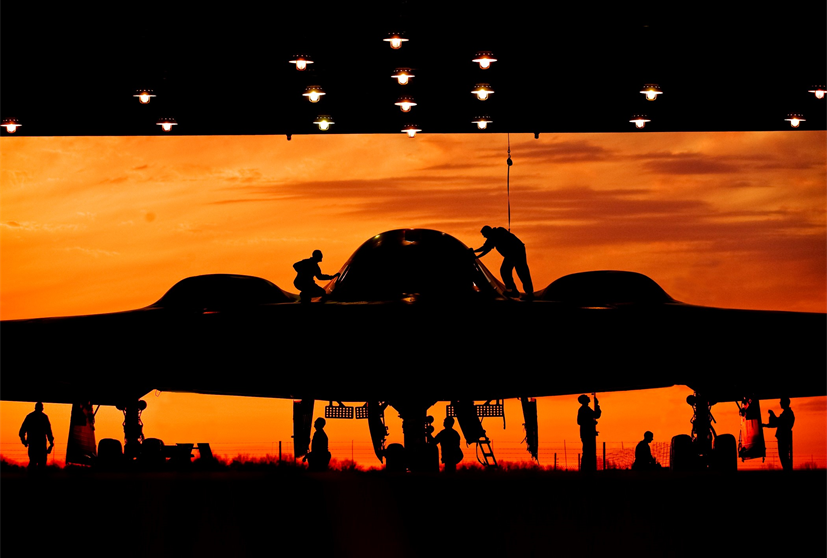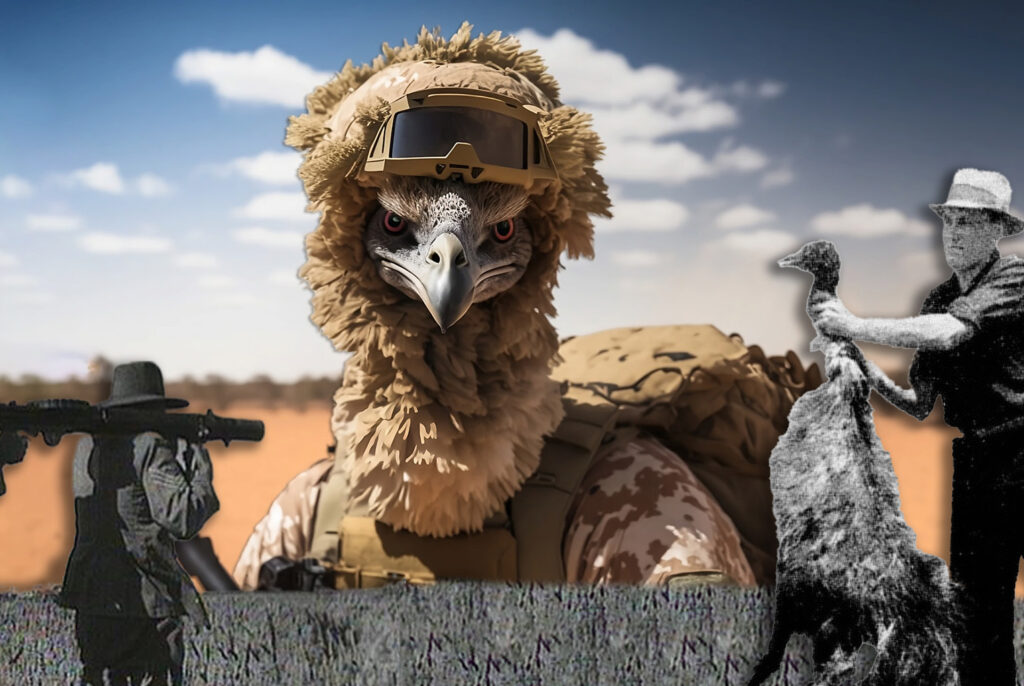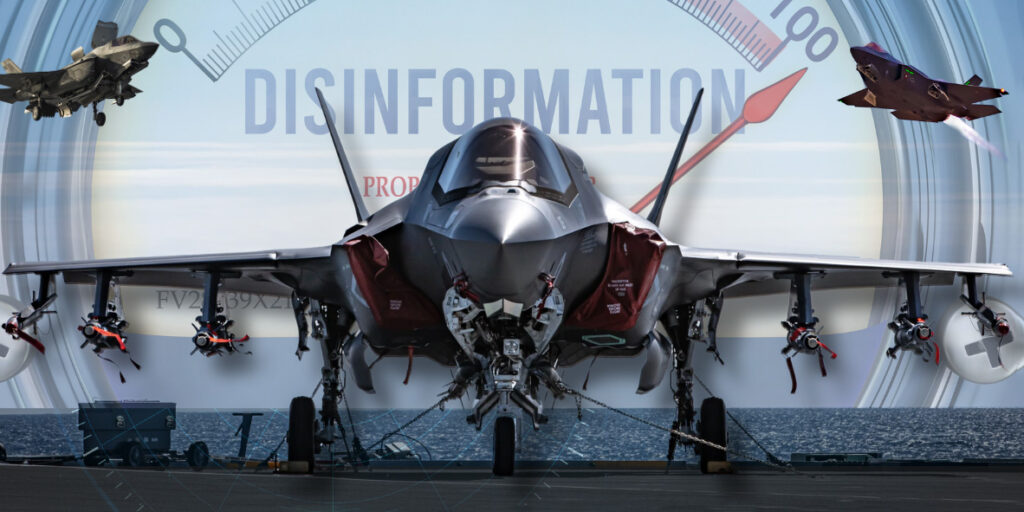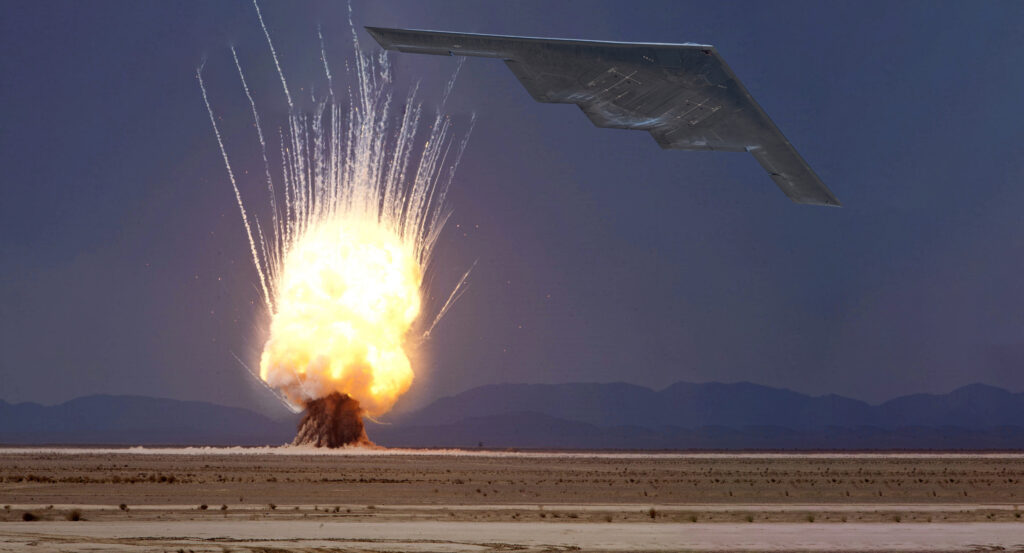Everything you need to know about the B-21 Raider being unveiled in December
- By Alex Hollings
Share This Article

America’s long-awaited and highly secretive B-21 Raider – potentially the stealthiest aircraft ever to fly – will finally be revealed later this year, according to recent Northrop Grumman and Air Force announcements.
The Northrop Grumman-led B-21 effort began in 2015 under the unassuming title of Long Range Strike-Bomber (LRS-B) and has since then served as a clinic in secrecy in the modern era. Despite the presence of high-resolution cameras in just about every pocket these days, not a single image of the B-21 has managed to leak onto the internet over seven years of development and with six test-model aircraft already nearing completion.
The new stealth bomber builds upon the success of its legendary precursor, the Northrop Grumman B-2 Spirit, but is said to leverage stealth technology that’s at least “two generations” ahead of America’s long-serving flying wing. That — in itself — is a significant claim. Despite being in service for a quarter-century, the B-2 is still touted as among the stealthiest aircraft in the world.
Related: America’s secret stealth aircraft you’ve never heard of
The world’s first new stealth bomber in 34 years

On November 22, 1988, the massive hangar doors of Northrop’s Palmdale assembly plant cracked open to a chorus of cheering spectators. As daylight enveloped the sleek black mass inside, an aircraft, unlike any before slowly took shape, flanked on either side by security with guard dogs. The 172-foot wingspan bore a resemblance to flying wings developed throughout history — from the Soviet Chyeranovskii BICh series of test planes in the 1920s to Northrop’s own YB-49 in the 1940s… but this shadowy jet leveraged this inherently unstable design to entirely new ends.
“We are not just rolling out America’s newest strategic bomber,” said Air Force Secretary Edward C. Aldridge Jr. at the time.
“We are ushering in a new age of strategic deterrence.”
Early experiments with flying wings were mostly about aerodynamic efficiency. A flying wing design does away with things like vertical tail surfaces — which provide stability at the expense of increased drag. The flying wing design, then, was seen as a means to increase fuel efficiency. But while it’s true that flying wings are aerodynamically efficient, the lack of fuselage requires that the wing itself be vertically thick, or tall enough to accommodate passengers and equipment inside, limiting the efficacy of its aerodynamic profile.

Despite boasting a nearly 7,000-mile unrefueled range, this new bomber’s sleek design wasn’t designed around fuel efficiency, however. It was purpose-built to defeat the most advanced and capable air defense systems in the world by leveraging a new technology known as stealth.
The U.S. government had acknowledged the existence of stealth technology for the first time in 1980, but to that point, the world had never seen a stealth aircraft before. The F-117 Nighthawk, which had been in service since 1983, wouldn’t be revealed to the public for another two years.
Reporters and onlookers were kept behind ropes 200 feet away from the aircraft with its nose facing them. At the time, the public wasn’t even allowed to see what the back of the advanced new bomber looked like. The day after the unveiling, Air Force Secretary Edward C. Aldridge Jr. was quoted by the Washington Post as saying that if he had his way, he’d never let the Soviets get any closer to it than the press that day — 200 feet was just fine with him. The technology found not only within this new bomber but adorning it was simply too important.
At the time, there were pressing concerns that the Soviets could copy the technology found in the B-2 to develop their own stealth bomber.

Today, 34 years later, America has managed to maintain its monopoly on heavy payload stealth bomber technology… but that lead is waning. Not only do both China and Russia have stealth bombers cruising toward service, but advanced air defense systems have mitigated the advantage offered by the Spirit’s stealthy profile to some extent.
For the first time in more than three decades, America needs a new stealth bomber. And in the first week of December, it’ll get one — rolling out of the very same Palmdale assembly plant as its predecessor.
Northrop Grumman’s B-21 Raider also resembles flying wing designs found throughout history — but like the Spirit before it, the Raider’s simplistic-looking shape hides a technologically massive leap in battlefield capability. The Raider is expected to be smaller than the B-2 Spirit, which boasts a payload capacity of 60,000 pounds, but what it lacks in size it will make up for in discretion.
Related: How the B-21 Raider could shift power in the Pacific
The B-21 will be even stealthier than the F-35 or F-22

The B-21 benefits from more than three decades worth of advancement in stealth design since the B-2 first started flying, allowing for a more streamlined and effective shape capable of wicking away enemy efforts to both detect and target the new bomber.
The basic premise behind stealth was born out of the work of Soviet physicist and mathematician Pyotr Ufimtsev. His 40-page academic paper entitled, “Method of Edge Waves in the Physical Theory of Diffraction,” translated by the Air Force’s Foreign Technology Division in September of 1971, drew little acclaim within his home country. But the translation found its way to the Skunk Works’ in-house mathematician and radar specialist, Denys Overholser. While Ufimtsev is often credited as “the father of stealth,” it was Overholser who figured out how to apply his work to a mathematical equation that could calculate the radar cross-section of three-dimensional aircraft designs — paving the way for its future use.

But math is hard, and the complexity of radar-deflecting design was still difficult to manage even with the advent of computers. The jagged angles of the Hopeless Diamond and the F-117 Nighthawk it bore were the result of this difficult compromise between stealth calculations and aerodynamic requirements. Northrop, who competed with Lockheed for the F-117 contract and lost, didn’t give up on their stealth ambitions — rolling the lessons they’d learned in the process into a new platform that would offer a huge leap in capability over even Lockheed’s Nighthawk.
Rapid leaps in computing power soon made it possible to create sleek stealth designs, leveraging the same calculations but on a much smaller scale. Today, the compromise between stealth and aerodynamics is far less pronounced as a result, and the B-21 represents the latest development in this steadily-improving marriage of design concepts.
The result of these advancements can be seen clearly in modern stealth fighters like the F-35 and F-22, but it might surprise many to learn that Northrop’s B-2 is actually stealthier than either of these 5th-generation fighters.
Related: Kelly Johnson: How one man changed aviation forever
The stealth benefits of a flying wing

The B-2 Spirit first flew in 1989 — 16 years before the F-22 entered service and 26 years before the F-35 reached initial operating capability with the Marine Corps. And while both of these stealth fighters are practically without peer in terms of overall low observability within the fighter realm, the B-2 remains harder to detect and track than either of these cutting-edge jets. The B-21 Raider will extend this advantage even further.
Stealth designs minimize an aircraft’s radar signature, delaying and sometimes even preventing detection, but because of the aerobatic performance required of tactical fighters, jets like the F-35 have to include things like vertical tail surfaces for maneuverability and control.

These facets of fighter design can be optimized to limit detectability against high-frequency radar systems, but they still tend to produce a return against low-frequency early warning arrays that aren’t capable of actually guiding a weapon to a target. In fact, it’s not uncommon for air traffic control radar to spot stealth fighters on their scopes, even when flying without radar reflectors or external fuel tanks and munitions.

Stealth bombers like the B-2 Spirit and B-21 Raider, on the other hand, don’t need to be able to perform the same high-G stunts you’d expect out of a fighter, and that means they can omit common facets of stealth fighter designs like the tail section. As a result, these stealthy flying wings are not only extremely difficult to target using high-frequency fire-control radars but also extremely difficult to even detect using low-frequency radars that can easily spot inbound stealth fighters.
Related: America’s enemies can track stealth fighters on radar
The best-kept secret in stealth will be on full display on the B-21

It’s not just the design of the B-21 Raider that will make it stealthier than its predecessor — it will also benefit from significant advancements in material sciences. A radar-deflecting design isn’t enough to make a modern aircraft truly stealthy. They’re also covered in layers of radar-absorbing materials (RAM) that significantly minimize their radar returns. These materials help to smooth out the finish of a stealth aircraft, as even a small blemish or crack in the fuselage could compromise its low observable profile. More importantly, RAM converts radar waves hitting the aircraft into heat that it can simply dissipate.
“RAM works on the principle of the aircraft absorbing the electromagnetic wave energy to minimize the intensity of the reflected signal,†wrote Adrian Mouritz in the academic textbook “Introduction to Aerospace Materials.â€
The RAM leveraged by today’s stealth fighters is rated to absorb a whopping 70-80% of inbound electromagnetic energy (radar waves), but it’s also extremely expensive, time-consuming to maintain, and susceptible to damage when exposed to things like high-heat, water, or salt. Developments in RAM technology are among the most closely-guarded secrets in the Defense technology world, but there’s evidence to suggest that Northrop Grumman has been making continued strides in this realm over the past thirty years.

In 2004, Northrop Grumman announced it would begin coating America’s B-2 fleet in a new RAM coating they dubbed alternate high-frequency material (AHFM). This new RAM eliminated the need for approximately 3,000 feet of RAM tape applied to the aircraft after each maintenance cycle, offering the same radar-absorbing performance while reducing maintenance requirements. But they certainly weren’t done there.
In 2017, Northrop Grumman was awarded $35.8 million to build a new “coatings facility” at the same Palmdale, California plant in which the B-21 Raider is now being built — though the contract and Northrop releases at the time did not mention the bomber by name. By 2021, however, Northrop Grumman was no longer being as shy about advancements in their coating process. While not discussing any potential improvements in the B-21 coatings’ ability to absorb energy, Northrop’s vice president of the Strike Division, Steve Sullivan, was clear that the materials leveraged for the new bomber would be a big improvement over the B-2.
“Through the application of lessons learned on B-2 and other stealth aircraft, and the use of digital engineering techniques, not only do we have a design that has significantly improved over the B-2 from both a survivability and aero-performance perspective, we also now have a coating system that is as revolutionary in its maintainability as the original B-2 systems were in their stealth performance,†he told Breaking Defense.

As we’ve discussed in previous stories, the recent advent of ceramic-based RAM coatings — which are said to absorb upwards of 90% of electromagnetic energy — could be a huge development in stealth aviation. This material is harder than sand, can withstand temperatures over 1,800 degrees Fahrenheit, and would require significantly less maintenance than existing polymer RAM.
In 2020, a North Carolina State University team received a contract from the Air Force Office of Scientific Research to continue the development of their ceramic RAM concept. It seems unlikely that this material will be a part of the B-21 when it enters service later this decade. However, as early as 2012, outlets like Popular Science were already associating Northrop Grumman’s next bomber with Ceno Technologies’ efforts to field a new form of RAM that replaced the iron used in existing materials for hollow ceramic spheres, called cenospheres.
These cenospheres could be covered in different kinds of materials to result in a lighter and more durable RAM that could also be customized to absorb radar waves broadcast at difference specific frequencies. It’s unclear whether the B-21 will actually leverage this or a similar form of advanced RAM… and the truth is, we can expect Northrop Grumman to stay fairly tight-lipped about it anyway. RAM science, like electronic warfare, is a realm where firms tend to keep the nuts and bolts of new advancements rather tight to the chest.
Related: The technology that could make hypersonic stealth fighters a reality
The B-21 will be pivotal for deterrence in the Pacific

Although China’s Naval presence in the Pacific already outnumbers America’s global Navy in terms of hulls, the most potent threat China poses to American power projection capabilities isn’t the number of ships they have, but rather their growing stockpile of anti-ship weapon systems. China’s anti-ship ballistic missiles, weapons like the DF-21D, boast ranges in excess of a thousand miles, and modern hypersonic anti-ship weapons like the DF-ZF are considered to be all but indefensible for current technology.
These weapons have created an area-denial bubble extending a thousand miles or more from Chinese shores, preventing American aircraft carriers from sailing close enough to launch combat sorties of F-35Cs or F/A-18 Super Hornets without being vulnerable to attack. Losing just one of America’s 11 supercarriers to a relatively small number of missiles could be as devastating to the basis of America’s Naval military doctrine as the sinking of the HMS Prince of Wales and Repulse by Japanese bombers were for the battleship in World War II. In fact, some have already argued that the era of the supercarrier is over thanks to the advent of relatively lower-cost, high-capability anti-ship weapons like those employed by China.
But the B-21 Raider could offset this area-denial advantage thanks to its extremely low observability, payload capability, and long-range mission set. As the stealthiest aircraft in the American arsenal, the B-21 will be perhaps the only platform that could close with Chinese defenses in the early hours of a conflict, and thanks to the ability to deploy long-range, low-observable weapons like the AGM-158B JASSM-ER, it could launch strikes against known Chinese anti-ship weapon systems from literally hundreds of miles away while flying completely undetected.
By launching early strikes with the B-21 Raider and cruise-missile-carrying submarines, the U.S. could effectively clear a path of sorts for carrier strike groups to close in and begin doing what they do best.
Related: How the B-21 Raider could shift power in the Pacific
The B-21 Raider will be part of the first in a new generation of Airpower

In the latter half of the 20th century, the United States emerged as the global leader in airpower technology, from high-performing fighters like the F-15 and F-16 to extremely stealthy bombers like the B-2 Spirit. Now, as the B-21 cruises toward service, it will be the first of a new bevy of advanced platforms that are soon to fill American hangars.
The B-21 Raider will enter service sometime in the mid-2020s, followed by the Air Force’s Next Generation Air Dominance fighter in the mid-2030s and the Navy’s F/A-XX fighter shortly after that.
The B-21 Raider won’t just replace the B-2 Spirit — it will also replace the supersonic heavy-payload B-1B Lancer. It will be able to do so because the Air Force intends to procure more than 100 of these new bombers — five times the quantity of B-2s ever delivered. And considering the B-21 Raider has consistently been reported as on-time and on-budget, this is one stealth program that might actually get to see deliveries meet projections.
In a real way, the unveiling of the B-21 Raider is as exciting today as the unveiling of its predecessor all the way back in 1988. Like the B-2, this new bomber could change how America approaches airborne warfare, complicate the combat calculus potential opponents need to address when challenging the nation, and raise the bar in terms of what stealth can accomplish, both for deterrence and combat capability.
But unlike the B-2’s unveiling 34 years ago… I’m all grown up now.
So hey, Northrop Grumman… send me an invite, would ya?
Read more from Sandboxx News
- How one Serbian commander proved stealth is not invisibility
- Fighter Comparison: Russia’s stealth fleet ranks 11th in the world
- India tests its own stealth combat drone in an effort to boost its defense industry
- Everything we know about the Air Force’s new drone stealth bomber effort
- Could a stealth makeover save the A-10? How to drag the Warthog into the future

Alex Hollings
Alex Hollings is a writer, dad, and Marine veteran.
Related to: Airpower

The A-12 Avenger II would’ve been America’s first real ‘stealth fighter’

No, Australia never lost the ‘Great Emu War’ of 1932

Why media coverage of the F-35 repeatedly misses the mark

